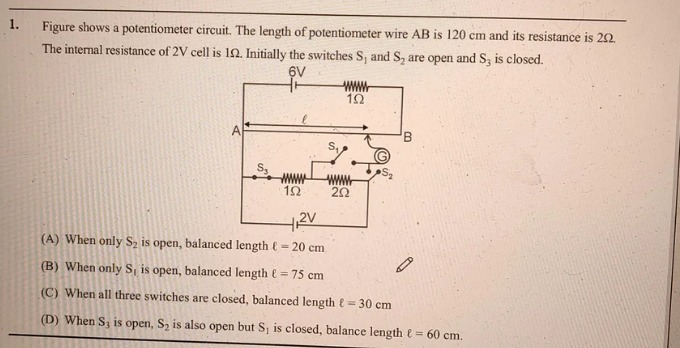Question
Question: Figure shows a potentiometer circuit. The length of potentiometer wire AB is 120 cm and its resistan...
Figure shows a potentiometer circuit. The length of potentiometer wire AB is 120 cm and its resistance is 2Ω. The internal resistance of 2V cell is 1Ω. Initially the switches S1 and S2 are open and S3 is closed.

When only S2 is open, balanced length ℓ = 20 cm
When only S1 is open, balanced length ℓ = 75 cm
When all three switches are closed, balanced length ℓ = 30 cm
When S3 is open, S2 is also open but S1 is closed, balance length ℓ = 60 cm.
C
Solution
The potential gradient along the potentiometer wire AB is k=LABVAB.
The total resistance of the primary circuit is Rtotal=RAB+Rext=2Ω+1Ω=3Ω.
The current in the primary circuit is Ip=RtotalEMFprimary=3Ω6V=2A.
The potential difference across the potentiometer wire AB is VAB=Ip×RAB=2A×2Ω=4V.
The potential gradient is k=120cm4V=301V/cm.
(A) When only S2 is open, S1 and S3 are closed. The galvanometer is connected to the junction between the 1Ω and 2Ω resistors. Point A is connected to the negative terminal of the 2V cell. The positive terminal of the 2V cell is connected to the series combination of the internal resistance (1Ω) and the 1Ω resistor (since S3 is closed). This series combination is connected to the junction between the 1Ω and 2Ω resistors. The potential difference between A and the junction is the potential difference across the 2V cell and the 1Ω internal resistance and the 1Ω external resistor. The current in the secondary circuit is Is=1Ω+1Ω+2Ω2V=42=0.5A.
The potential difference between A (negative terminal) and the junction between 1Ω and 2Ω is VAJ=Vcell−Is(r+R3)=2V−0.5A(1Ω+1Ω)=2V−0.5A×2Ω=2V−1V=1V.
Balanced length ℓ=kVAJ=1/30V/cm1V=30cm. Option (A) is incorrect.
(B) When only S1 is open, S2 and S3 are closed. The galvanometer is connected to the point after the 2Ω resistor. This point is the positive terminal of the 2V cell. Point A is the negative terminal. The potential difference to be balanced is the terminal voltage of the 2V cell. The current in the secondary circuit is Is=1Ω+1Ω+2Ω2V=0.5A. The terminal voltage is Vt=EMF−Isr=2V−0.5A×1Ω=2V−0.5V=1.5V.
Balanced length ℓ=kVt=1/30V/cm1.5V=1.5×30cm=45cm. Option (B) is incorrect.
(C) When all three switches are closed, S1,S2,S3 are closed. The galvanometer is connected between the jockey and the junction between the 1Ω and 2Ω resistors. Point A is connected to the negative terminal of the 2V cell. The positive terminal of the 2V cell is connected to the series combination of the internal resistance (1Ω) and the 1Ω resistor (since S3 is closed). This series combination is connected to the junction between the 1Ω and 2Ω resistors. This is the same configuration as in (A).
Potential difference to be balanced is 1V. Balanced length ℓ=1/30V/cm1V=30cm. Option (C) is correct.
(D) When S3 is open, S2 is also open but S1 is closed. S3 and S2 are open, S1 is closed. The galvanometer is connected to the junction between the 1Ω and 2Ω resistors. Since S3 is open, the 1Ω resistor in series with S3 is not in the circuit. The secondary circuit consists of the 2V cell with internal resistance 1Ω and the 2Ω resistor. The galvanometer is connected to the junction between the cell and the 2Ω resistor. Point A is connected to the negative terminal of the 2V cell. The galvanometer is connected to the positive terminal of the 2V cell.
The potential difference to be balanced is the terminal voltage of the 2V cell. The current in the secondary circuit is Is=1Ω+2Ω2V=32A. The terminal voltage is Vt=EMF−Isr=2V−32A×1Ω=2V−32V=34V.
Balanced length ℓ=kVt=1/30V/cm4/3V=34×30cm=4×10cm=40cm. Option (D) is incorrect.
